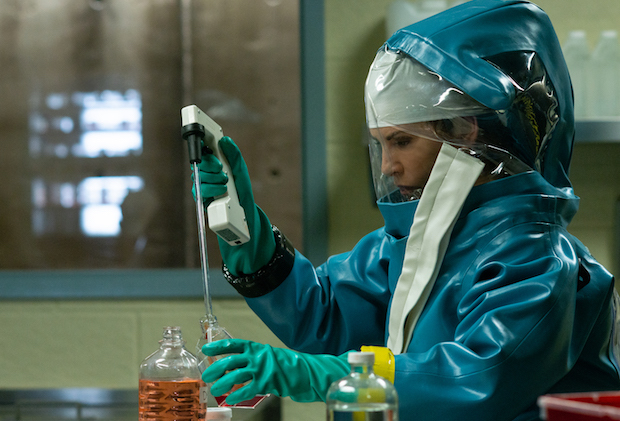By Dustin Rowles | TV | May 29, 2019

National Geographic’s six-part miniseries The Hot Zone feels like taking a break from the horrors of the world, but only in the sense that I’ve also been watching Chernobyl (we will review that separately soon), and relatively speaking, The Hot Zone is like the PG-13 version of the HBO series. As horrifying as Ebola is, at least it takes its victims relatively quickly compared to the radiation poisoning of Chernobyl. Also, The Hot Zone is not as adamant about making us stare at the victims, and stew in the agonizing effects of radiation.
National Geographic wisely took a slow-week on the television schedule and dumped all six-parts of its miniseries over the course of three days. I don’t say “dumped” in a negative sense, either. It was wise to get it out as soon as possible because it might otherwise be more tempting for viewers to spoil themselves by reading the account that the miniseries is based upon (a New Yorker piece by Richard Preston called “Crisis in the Hot Zone,” later expanded into a nonfiction book by the same author).
I am reluctant to spoil it, except to say that it is inspired by actual events, specifically an Ebola outbreak in the Washington D.C. area in 1989. I don’t want to say anything else thus depriving the viewer of the illusion of stakes, except to say that it could have been much worse than is depicted in the miniseries. This particular outbreak could have wiped humanity off the face of the Earth. “The earth’s immune system, so to speak, has recognized the presence of the human species,” Preston writes in his book, “and is starting to kick in. The earth is attempting to rid itself of an infection by the human parasite.”
That pall of ominousness hangs over the events of the miniseries, which begins in 1989 when a sample from a monkey is shipped from Reston, Virginia to the U.S. Army Medical Research Institute of Infectious Diseases (USAMRIID) in Frederick, Maryland. The sample comes from one of several infected monkeys being used for scientific testing. Several folks, including Peter Jarhling (Topher Grace), assume it’s some sort of monkey flu, but Dr. Nancy Jaax (Julianna Margulies) insists on doing further testing to rule out something more sinister.
Jaax soon realizes that the monkeys have been infected with a strain of Ebola, and based on her understanding of that disease — largely illustrated in flashbacks to an Ebola outbreak in Africa that Wade Carter (Game of Thrones’ Liam Cunningham) is witness to — Jaax knows how quickly the disease can spread. There’s a 90 percent mortality rate, the symptoms are brutal, and it’s far more contagious than another virus spreading around the same time, AIDS. The outlook is bleak, and it is incumbent upon Jaax to get into the Reston facility and kill and dispose of all the infected monkeys, which basically requires sending in volunteers from the military who are willing to put their individual lives at risk to save millions (not unlike a similar situation in Chernobyl).
Of course, all of this is a bureaucratic nightmare. There are jurisdictional pissing matches with the CDC, and there are concerns that the panic that would ensue if this went public could be more damaging than the virus itself. Meanwhile, some of those in the USAMRIID who have come into contact with the virus are paranoid and freaking out, fearing that they’ve contracted Ebola (the gestation period is up to three weeks, which is obviously a terrifying prospect, because anyone who has come in contact with the virus could have unknowingly spread it within the gestation period).
A lot is going on, but there are also a few soap opera elements to keep viewers glued, like arguments over how to handle the situation between Jaax and her husband, Jerry (Noah Emmerich), who happens to be in charge of diseased animals for the Department of Defense. There’s also a rivalry between the conspiratorial Wade Carter and his old partner, Trevor Rhodes (James D’Arcy), the skeptic who is in charge of the CDC.
Ultimately, the underlying true story and the acting talent on display make for a compelling television miniseries, even if the writing and the staid direction often give it the feel of a TV movie of the week (Topher Grace’s 1989 eyeglasses don’t help). Essentially, it’s a less harrowing alternative to Chernobyl for those who justifiably do not have the stomach for the more graphic and searing HBO series but still want to watch a true-to-life show where the threat of mass casualties exist.
(If you are curious, and you have no plans to watch ‘The Hot Zone,’ you can find a crucial, real-life spoiler here).